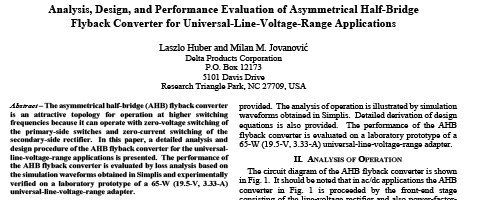In this paper. a detailed analysis and design procedure of the AHB flyback converter for the universal line-voltage range is provided. The analysis of operation is illustrated by simulation waveforms obtained in Simplis. It is shown that the primaryside switches operate with zero-voltage switching (ZVS). whereas. the secondary-side rectifier operates with zerocurrent switching (ZCS). resulting in significantly reduced switching losses. The implementation of operation of the AHB flyback converter for a wide input-voltage range requires operation with variable switching frequency. In simulations. the control circuit is implemented with voltage-mode control and by sensing the zero crossing of the secondary-side rectifier current. Detailed derivation of design equations is also provided. The performance of the AHB flyback converter is evaluated by loss analysis based on simulation waveforms obtained in Simplis. The core loss of the transformer is calculated by using the core-loss calculation software from Ferroxcube [18]. It is shown that at higher input voltages. the core loss of the transformer significantly increases. resulting in reduced efficiency. Experimental waveforms and efficiency measurements obtained on a 65-W (19.5-V. 3.33-A) laboratory prototype of the AHB flyback converter for the universal-linevoltage range are also presented. The experimental control circuit is implemented in open loop by generating the gate signals for the primary-side switches and the secondary-side synchronous rectifier through a DSP and a corresponding GUI software.

 Iran Energy News Oil, Gas, Petrochemical and Energy Field Specialized Channel
Iran Energy News Oil, Gas, Petrochemical and Energy Field Specialized Channel



